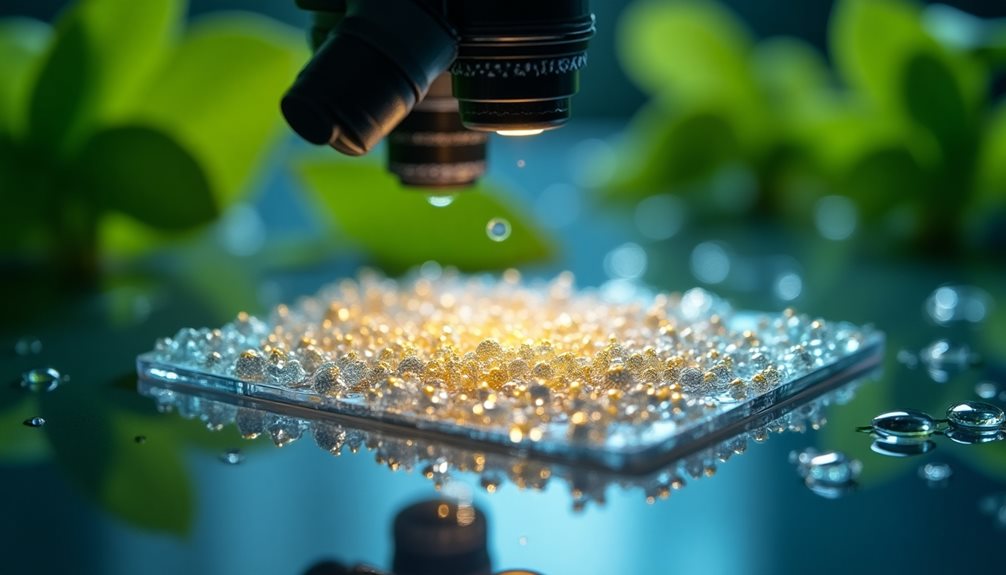Table of Contents
ToggleUnderstanding Nanotechnology: A Brief Overview

While nanotechnology encompasses a broad range of scientific disciplines, it fundamentally focuses on manipulating matter at the nanoscale, typically between 1 and 100 nanometers. This manipulation enables a variety of nanotechnology applications, including advancements in medicine, energy storage, and materials science.
For instance, nanoparticles can enhance drug delivery systems, improving therapeutic efficacy while minimizing side effects.
However, the field also faces significant nanotechnology challenges, such as ethical concerns related to environmental impact and potential health risks. Regulatory frameworks are still evolving to address these issues effectively.
As research progresses, the balance between innovation and safety remains critical, necessitating a thorough understanding of both the potential benefits and the inherent risks associated with nanoscale technologies.
Key Terms in Nanotechnology / Ключевые термины в нанотехнологиях
Key terms in nanotechnology serve as the foundation for understanding the intricate concepts and processes that define this rapidly evolving field. Familiarity with these terms is essential for effective interdisciplinary collaboration and addressing nanotechnology ethics.
Below, you will find expanded explanations of key nanotechnology terms, each paired with their Russian equivalents, along with a comprehensive table to help you learn and remember these terms.
Expanded Key Terms
1. Nanoparticle
A nanoparticle is a small particle with dimensions between 1 and 100 nanometers. These particles are widely used in medicine (for targeted drug delivery), electronics, and environmental applications.
- Example: Gold nanoparticles are used for cancer detection because they can bind to specific molecules in the body.
2. Self-assembly
Self-assembly describes how molecules or nanoparticles automatically organize themselves into ordered structures without human intervention. This principle is used to create complex nanomaterials with specific properties.
- Example: DNA strands can self-assemble into double helix structures.
3. Quantum dots
Quantum dots are tiny semiconductor particles only a few nanometers in size. They have unique optical and electronic properties, making them useful in displays, solar cells, and biological imaging.
- Example: Quantum dots are used in some modern TV screens for better color brightness.
4. Nanocomposites
Nanocomposites are materials made by mixing nanoparticles into other materials to improve features like strength, flexibility, or heat resistance.
- Example: Car bumpers often use nanocomposite plastics for increased durability.
Related Russian Terms Table
| English Term | Russian (Cyrillic) | Russian (Phonetic) | English Definition |
|---|---|---|---|
| Nanoparticle | Наночастица | nanochastitsa | A particle sized between 1–100 nanometers |
| Self-assembly | Самосборка | samosborka | Process where molecules form organized structures |
| Quantum dot | Квантовая точка | kvantovaya tochka | Tiny semiconductor with special optical properties |
| Nanocomposite | Нанокомпозит | nanokompozit | Material combining nanoparticles and other substances |
| Nanoscale | Наномасштаб | nanomasshtab | Size scale measured in nanometers |
| Nanotechnology | Нанотехнология | nanotekhnologiya | Science/tech at the nanoscale |
| Surface area | Поверхностная площадь | poverkhnostnaya ploshchad | Total area of the surface of a material |
| Molecular | Молекулярный | molekulyarny | Relating to molecules |
| Atomic force microscope | Микроскоп атомных сил | mikroskop atomnykh sil | Tool to visualize surfaces at the nanoscale |
| Drug delivery | Доставка лекарств | dostavka lekarstv | Transporting medicine to specific body sites |
Familiarity with these terms in both English and Russian will strengthen your understanding of nanotechnology and support effective communication in interdisciplinary and international settings.
Common Nanomaterials and Their Applications
Understanding the fundamental terms in nanotechnology lays the groundwork for exploring the diverse range of nanomaterials and their applications. Nanomaterials are materials with structures at the nanoscale, typically less than 100 nanometers. Their special properties arise from their tiny size, leading to new uses not possible with larger-scale materials.
Among the most notable nanomaterials are carbon nanotubes, which exhibit exceptional strength, electrical conductivity, and thermal properties. Their applications span from reinforcing materials in composites to enhancing energy storage devices and drug delivery systems.
Similarly, metallic nanoparticles, such as gold and silver, have garnered attention for their unique optical and catalytic properties. The uses of metallic nanoparticles include targeted drug delivery, imaging in biomedical applications, and as catalysts in chemical reactions.
These advancements illustrate the transformative potential of nanomaterials in various fields, paving the way for innovative solutions across technology, medicine, and environmental science.
Key Nanomaterial Terms in Russian
1. Carbon Nanotubes
Russian: углеродные нанотрубки
Phonetic: ugleródnye nanotróbki
Meaning: carbon nanotubes
- Strength (прочность) — próchnoct’ — strength
- Conductivity (проводимость) — provodímosť — conductivity
- Composite materials (композиционные материалы) — kompozitsiónnye materyály — composite materials
Example:
Углеродные нанотрубки используются для усиления композиционных материалов.
(Ugleródnye nanotróbki ispol’zuyutsya dlya usileniya kompozitsiónnykh materyálov.)
Carbon nanotubes are used to reinforce composite materials.
2. Metallic Nanoparticles
Russian: металлические наночастицы
Phonetic: metállitcheskiye nanochastítsy
Meaning: metallic nanoparticles
- Gold (золото) — zóloto — gold
- Silver (серебро) — serebró — silver
- Catalyst (катализатор) — katalizatór — catalyst
- Drug delivery (доставка лекарств) — dostávka lekarstv — drug delivery
- Imaging (визуализация) — vizualizátsiya — imaging
Example:
Металлические наночастицы золота применяются для доставки лекарств.
(Metállitcheskiye nanochastítsy zólota primenyáyutsya dlya dostávki lekarstv.)
Gold metallic nanoparticles are used for drug delivery.
Example Sentences
- Нанотехнология открывает новые возможности в медицине и промышленности.
(Nanotekhnologíya otkrývayet nové vozmozhnosti v meditsíne i promýshlennosti.)
Nanotechnology opens new opportunities in medicine and industry. - Свойства наноматериалов зависят от их размеров и структуры.
(Svoystva nanomateryálov zavísyat ot ikh razmérov i struktúry.)
The properties of nanomaterials depend on their size and structure.
Learning these terms will help you discuss nanotechnology topics with Russian speakers and understand scientific texts in this area.
Nanoscale Measurements and Techniques
Nanoscale measurements and techniques are essential for characterizing materials and phenomena at the atomic and molecular levels, enabling researchers to gain insights into the properties and behaviors of nanomaterials.
Various approaches are employed to achieve this, utilizing advanced tools and methods. Key techniques include:
- Atomic Force Microscopy (AFM (АФМ)) – Offers high-resolution imaging of surfaces at the nanoscale.
- Scanning Tunneling Microscopy (STM (СТМ)) – Provides detailed electronic structure information of conductive materials.
- Transmission Electron Microscopy (TEM (ТЭМ)) – Delivers precise imaging and analysis of nanostructures.
- X-ray Diffraction (XRD (Рентгеновская дифракция)) – Facilitates the determination of crystal structures and phase identification.
These nanoscale imaging techniques and precision measurement tools empower researchers to explore and manipulate nanomaterials effectively, driving innovation across various fields.
Nanotechnology in Medicine
The integration of nanotechnology in medicine represents a transformative advancement in healthcare, offering innovative solutions for diagnosis, treatment, and prevention of diseases. One prominent application is nanoparticle therapy, which utilizes engineered nanoparticles for targeted drug delivery. This method enhances the efficacy of medications while minimizing side effects, revolutionizing treatment protocols, particularly in oncology.
Main Applications / Основные применения
- Nanoparticle Therapy (Наночастичная терапия)
- Example: Treating brain tumors by sending medicine across the blood-brain barrier using nanoparticles.
- Targeted Drug Delivery (Таргетная доставка лекарств)
- Example: Delivering chemotherapy straight to cancer cells, sparing healthy cells.
- Diagnostic Imaging (Диагностическая визуализация)
- Example: Using nanoparticles to improve MRI scans so doctors can spot diseases earlier.
- Gene Therapy (Генная терапия)
- Example: Using nanoparticles to deliver healthy genes into a patient’s cells to fix genetic disorders.
- Vaccine Development (Разработка вакцин)
- Example: Creating vaccines that use nanoparticles to train the immune system more effectively.
Related Russian Terms Table
| Russian (Cyrillic) | English Phonetic | English Definition |
|---|---|---|
| Нанотехнологии | nanotekhnologii | Nanotechnologies |
| Наночастица | nanochastitsa | Nanoparticle |
| Терапия | terapiya | Therapy |
| Доставка лекарств | dostavka lekarstv | Drug delivery |
| Таргетная доставка | targetnaya dostavka | Targeted delivery |
| Диагностическая визуализация | diagnosticheskaya vizualizatsiya | Diagnostic imaging |
| Генная терапия | gennaya terapiya | Gene therapy |
| Разработка вакцин | razrabotka vaktsin | Vaccine development |
| Иммунная система | immunnaya sistema | Immune system |
| Онкология | onkologiya | Oncology (study/treatment of cancer) |
| Побочные эффекты | pobochnye effekty | Side effects |
| Клетка | kletka | Cell |
| Лекарство | lekarstvo | Medicine/drug |
Nanotechnology is helping medicine become more precise and personal. By learning these Russian words, you can talk about these modern medical advances in both English and Russian.
Environmental Impacts of Nanotechnology

As nanotechnology continues to evolve, its environmental impacts have become a critical area of study. Understanding these effects is vital for promoting sustainable practices while addressing regulatory challenges.
1. Toxicity
Токсичность (Toksichnost’)
The introduction of nanomaterials into the environment raises concerns about their toxicity. For example, nanoparticles of silver (серебро — serebro) are used for their antibacterial properties but may also harm aquatic life by disrupting cell membranes. Researchers study how these particles interact with organisms and ecosystems to determine safe exposure levels.
Related terms:
- Наночастицы (nanochastitsy) – nanoparticles
- Экосистема (ekosistema) – ecosystem
- Здоровье человека (zdorov’ye cheloveka) – human health
2. Biodegradability
Биодеградация (Biodegradatsiya)
Some nanomaterials persist in the environment and resist natural breakdown. This can lead to accumulation in soil or water bodies. For instance, carbon nanotubes (углеродные нанотрубки — uglerodnye nanotrubki) have high stability and may remain in nature for years.
Related terms:
- Персистентность (persistetnost’) – persistence
- Почва (pochva) – soil
- Вода (voda) – water
3. Resource Efficiency
Рациональное использование ресурсов (Ratsional’noye ispol’zovaniye resursov)
Nanotechnology can help reduce environmental impact by improving resource efficiency. For example, nanomaterials in solar panels (солнечные панели — solnechnyye paneli) increase energy capture, while nano-coatings reduce waste in manufacturing processes.
Related terms:
- Энергопотребление (energopotrebleniye) – energy consumption
- Отходы (otkhody) – waste
- Производство (proizvodstvo) – production
4. Regulatory Frameworks
Регулирующие нормы (Reguliruyushchiye normy)
Governments are developing regulations to ensure the safe use of nanomaterials. This includes guidelines for production, labeling, and disposal. The aim is to minimize risks to both people and the planet.
Related terms:
- Безопасность (bezopasnost’) – safety
- Законодательство (zakonodatel’stvo) – legislation
- Контроль качества (kontrol’ kachestva) – quality control
Russian Terms Table for Environmental Impacts of Nanotechnology
| Русский | Phonetic | English Definition |
|---|---|---|
| Наночастицы | nanochastitsy | nanoparticles |
| Токсичность | toksichnost’ | toxicity |
| Экосистема | ekosistema | ecosystem |
| Биодеградация | biodegradatsiya | biodegradation |
| Персистентность | persistetnost’ | persistence |
| Почва | pochva | soil |
| Вода | voda | water |
| Энергопотребление | energopotrebleniye | energy consumption |
| Отходы | otkhody | waste |
| Производство | proizvodstvo | production |
| Регулирующие нормы | reguliruyushchiye normy | regulatory frameworks |
| Безопасность | bezopasnost’ | safety |
| Законодательство | zakonodatel’stvo | legislation |
| Контроль качества | kontrol’ kachestva | quality control |
| Здоровье человека | zdorov’ye cheloveka | human health |
| Углеродные нанотрубки | uglerodnye nanotrubki | carbon nanotubes |
| Солнечные панели | solnechnyye paneli | solar panels |
These factors highlight the necessity for ongoing research and dialogue among stakeholders to balance innovation with environmental stewardship.
Nanotechnology in Electronics
Advancements in nanotechnology are revolutionizing the field of electronics by enabling the development of smaller, more efficient components. Quantum dots, semiconductor nanocrystals, are increasingly utilized for their unique optical and electronic properties, allowing for enhanced display technologies and energy-efficient lighting.
Additionally, conductive polymers are emerging as essential materials that facilitate flexible electronic devices, offering significant advantages over traditional metals. These polymers can be engineered at the nanoscale to optimize conductivity and mechanical properties, leading to innovations in wearable technology and smart materials.
The integration of quantum dots and conductive polymers exemplifies the transformative potential of nanotechnology in electronics, promising devices that are not only more compact but also capable of delivering superior performance and versatility.
Related Russian Terms
Quantum Dots (Квантовые точки)
Quantum dots (квантовые точки) are nanoscale semiconductor crystals, typically ranging from 2 to 10 nanometers in size. Their quantum mechanical properties result in discrete energy levels, which can be tuned by altering the size or composition of the dots. This tunability enables:
- Enhanced Display Technologies (Улучшенные дисплейные технологии): Quantum dots are used in QLED displays, providing vibrant colors, higher brightness, and improved energy efficiency compared to conventional LEDs.
- Energy-efficient Lighting (Энергоэффективное освещение): Due to their high luminous efficiency and color purity, quantum dots are incorporated into advanced LED lighting systems, reducing power consumption.
Conductive Polymers (Проводящие полимеры)
Conductive polymers (проводящие полимеры) are organic materials that conduct electricity, offering unique advantages over traditional metallic conductors:
- Flexibility (Гибкость): These materials can be processed into thin films and flexible substrates, making them ideal for bendable and wearable electronics (гибкая и носимая электроника).
- Nanoscale Engineering (Наноструктурирование): At the nanoscale, conductive polymers can be chemically modified to optimize electrical conductivity (электропроводность) and mechanical strength (механическая прочность).
- Applications: They are crucial in the development of flexible displays, organic solar cells (органические солнечные элементы), sensors, and electronic textiles (электронные текстильные изделия).
Integration and Impact
The integration of quantum dots (квантовые точки) and conductive polymers (проводящие полимеры) highlights the transformative capacity of nanotechnology in electronics:
- Miniaturization (Миниатюризация): Enables the production of ultra-compact devices with advanced functionalities.
- Performance (Производительность): Devices exhibit improved energy efficiency, color quality, and responsiveness.
- Versatility (Универсальность): Supports innovation in areas such as smart materials (умные материалы), healthcare wearables, flexible displays, and next-generation lighting.
In summary, the ongoing advancements in nanotechnology are not only making electronic devices smaller and more efficient but are also opening up entirely new possibilities for device design, performance, and user experience by leveraging the unique properties of materials engineered at the nanoscale.
Future Trends in Nanotechnology
Emerging trends in nanotechnology indicate a promising trajectory for various fields, including medicine, energy, and environmental science.
As researchers explore quantum advancements, several future innovations are becoming apparent:
1. Targeted Drug Delivery (Таргетная доставка лекарств)
Nanoparticles can be engineered to find and attach to specific cells, like cancer cells, allowing medicine to act precisely where it is needed.
Example: Scientists are developing nanocapsules that deliver chemotherapy drugs directly to tumors, reducing side effects.
![]()
2. Energy Storage Solutions (Решения для хранения энергии)
Batteries made with nanomaterials such as graphene or carbon nanotubes can store more energy and charge faster.
Example: Electric cars may soon use nanotech-enhanced batteries for longer range and shorter charging times.
![]()
3. Water Purification Technologies (Технологии очистки воды)
Nanofilters can remove contaminants at the molecular level, making water purification more effective and accessible.
Example: Portable filtration devices using nanotechnology can provide clean water in disaster zones.
![]()
4. Flexible Electronics (Гибкая электроника)
Nanotechnology enables the creation of thin, bendable devices like foldable smartphones or wearable sensors.
Example: Smart clothing with embedded nanosensors can monitor health conditions in real time.
Russian Terms Table
| Russian (Cyrillic) | Phonetic (English) | English Definition |
|---|---|---|
| Нанотехнологии | nanotekhnologii | Nanotechnology |
| Наночастицы | nanochastitsy | Nanoparticles |
| Таргетная доставка лекарств | targetnaya dostavka lekarstv | Targeted drug delivery |
| Энергохранение | energokhraneniye | Energy storage |
| Наноматериалы | nanomaterialy | Nanomaterials |
| Гибкая электроника | gibkaya elektronika | Flexible electronics |
| Очистка воды | ochistka vody | Water purification |
| Фильтрация | filtratsiya | Filtration |
| Сверхконденсаторы | sverkhkondensatory | Supercapacitors |
| Графен | grafen | Graphene |
| Углеродные нанотрубки | uglerodnye nanotubki | Carbon nanotubes |
| Сенсор | sensor | Sensor |
| Молекула | molekula | Molecule |
These advancements hold the potential to redefine industries, enhancing capabilities and addressing global challenges through the remarkable versatility of nanotechnology.
Resources for Further Learning
While the field of nanotechnology continues to evolve, a variety of resources are available for those seeking to deepen their understanding and expertise.
Online courses offered by reputable institutions provide structured learning paths, covering fundamental concepts to advanced applications in nanotechnology. These courses often include interactive components, enabling learners to engage with the material actively.
Additionally, research articles published in peer-reviewed journals serve as invaluable resources, offering insights into the latest discoveries and innovations in the field. By accessing these articles, enthusiasts can stay informed about cutting-edge research and methodologies.
Frequently Asked Questions
What Career Opportunities Exist in the Field of Nanotechnology?
Career opportunities in nanotechnology are expanding considerably due to industry growth. Job prospects include roles in research, manufacturing, and regulatory affairs, offering diverse pathways for professionals seeking to innovate within this rapidly evolving field.
How Can I Start Learning About Nanotechnology Independently?
To start learning about nanotechnology independently, one can utilize self-study resources such as online courses and beginner tutorials. Engaging with academic papers and joining community forums further enhances understanding and fosters a deeper exploration of the subject.
Are There Online Courses Specifically for Nanotechnology Terminology?
Numerous online resources offer courses focused on nanotechnology terminology. Participants can enhance their understanding through interactive learning modules and terminology quizzes, providing an extensive approach to mastering essential concepts in the field of nanotechnology.
What Are the Safety Concerns Associated With Nanotechnology?
Safety concerns regarding nanotechnology encompass nanoparticle toxicity and the necessity for thorough risk assessment. Understanding potential biological impacts and environmental effects is essential for ensuring safe application and fostering public confidence in nanotechnological advancements.
How Does Nanotechnology Impact Everyday Consumer Products?
Nanotechnology greatly influences everyday consumer products through innovative nanotech applications. These advancements enhance performance, durability, and efficiency, providing substantial consumer benefits such as improved safety, reduced environmental impact, and enhanced functionality in various items.



